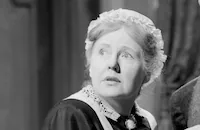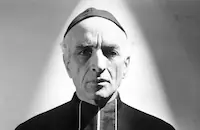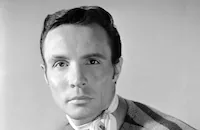Phantom of the Opera

Brief Synopsis
Cast & Crew
Arthur Lubin
Nelson Eddy
Susanna Foster
Claude Rains
Edgar Barrier
Leo Carrillo
Film Details
Technical Specs

Synopsis
After a performance of Martha at the Paris Opera House, police inspector Raoul Daubert proclaims his undying love to singer Christine DuBois, despite her known affections for both her career and baritone Anatole Garron. The conductor Villeneuve then tells Christine that she has great promise, but must choose between the opera and "a normal life." The news is not so fortunate for violinist Erique Claudin, who is fired after twenty years in the opera's orchestra. Returning home, he is threatened with eviction by his landlady, who questions his confessed poverty. The next day, he visits singing instructor Signor Ferretti, whom he has been secretly paying for three years to coach Christine. With no funds to continue the lessons, Claudin offers his new concerto to music publishers Pleyel and Desjardines. Later, after mistakenly believing that the music publisher has stolen his work, Claudin strangles Pleyel to death, then is facially disfigured when the publisher's assistant throws a tray of acid in his face. The violinist escapes into the sewers of Paris, and the next day, the master key of the opera house is stolen, as well as a costume and two masks. Meanwhile, as Christine sings Anatole a childhood lullaby, Raoul arrives to question her about the murderer, as a bust of her was found in Claudin's apartment. At a performance of Amour et Gloire , Christine hears Claudin's disembodied voice, telling her that, with his help, she is going to be a great singer. The mad violinist then drugs soprano Biancarolli's drink, and understudy Christine takes her place with great success. Biancarolli accuses Garron of drugging her and demands a police investigation. She agrees to drop all charges if Christine is returned to the chorus and no mention of her magnificent performance is published. Later, Claudin visits Biancarolli, ordering her to leave Paris, and when she refuses, murders the singer and her maid. The opera is closed by the police, only to have a note arrive, demanding Christine's performance. After Raoul agrees to re-open the opera, but with another singer, Lorenzi, in her place, to lure the murderer out, Christine is visited by her two suitors, who argue over their two plans to catch the killer. Anatole convinces Franz Liszt to perform Claudin's concerto as another lure and the opera house re-opens with Le prince masque de Caucasie. A new note from the "Phantom" is found, threating harm if Lorenzi performs in Christine's place. To gain access to the performers, Claudin kills an undercover policeman, taking his place backstage, and sends a giant chandelier crashing down on the audience when Lorenzi begins to sing. He then abducts Christine and takes her into the catacombs of the opera house. He tells her that she can sing now, but only for him. Upstairs, Anatole instructs Liszt to play Claudin's concerto, as he and Raoul search for the missing singer. Claudin accompanies the famous pianist, and Christine slowly recognizes the piece as her childhood lullaby. The two suitors follow the music of Claudin's piano and Christine's singing to find the Phantom and his captive. Just as Christine removes Claudin's mask and discovers his disfigured face, her rescuers arrive. Raoul attempts to shoot the advancing madman, but Anatole deflects his arm, sending the bullet into the ceiling and causing the collapse of the Phantom's lair. Anatole, Christine and Raoul escape the disintegrating walls, but Claudin is buried alive. Christine questions how Claudin composed the concerto around her lullaby, but Anatole tells her that she and Claudin were from the same part of France, and that it must be an old folk song of the area. As she utters sympathetic words about her patron, Anatole comforts her, stating that Claudin's madness will soon be forgotten, but his concerto will live forever. Later, after a triumphant performance, Christine is congratulated by her two suitors. They demand that she choose between them, but she elects instead to greet her adoring public. Realizing that she has made her choice, the baritone and the detective decide to dine together.

Director
Arthur Lubin
Cast

Nelson Eddy
Susanna Foster

Claude Rains
Edgar Barrier

Leo Carrillo
Jane Farrar

J. Edward Bromberg

Fritz Feld

Frank Puglia

Steven Geray

Barbara Everest

Hume Cronyn

Fritz Leiber
Nicki Andre
Gladys Blake
Elvira Curci
Hans Herbert
Kate Lawson

Miles Mander
Rosina Galli
Walter Stahl
Paul Marion
Beatrice Roberts
Marek Windheim
Belle Mitchell
Ernest Golm
Renee Carson
Stan Blystone
Cyril Delevanti
John Walsh
Dick Bartell
Muni Seroff

Jim Mitchell
Wheaton Chambers
Alphonse Martell
Edward Clark
Tudor Williams
Anthony Marlowe
Lane Chandler
Francis White
Crew
Bernard B. Brown
Frédéric Chopin
Friedrich Von Flotow
R. A. Gausman
Alexander Golitzen
John B. Goodman
Charles Gould
W. Howard Greene
Jack Gross
Joan Hathaway
Samuel Hoffenstein
Lester Horton
John Jacoby
Natalie Kalmus
Joe Lapis
Hal Mohr
Russell Schoengarth
Arthur Schutt
Eric Taylor
Peter Ilyich Tchaikovsky
William Tyroler
William Von Wymetal
William Von Wymetal
George Waggner
George Waggner
Edward Ward
Edward Ward
Ira S. Webb
Vera West
Harold Zweifel

Film Details
Technical Specs

Award Wins
Best Art Direction
Best Cinematography
Award Nominations
Best Score
Best Sound
Quotes
Mamouiselle, may I speak to you for a minute?- Enrique Claudin
Why, of course.- Christine DuBois
You weren't on the stage tonight for the third act curtain call.- Enrique Claudin
Everyone seems to notice. It's really quite flattering.- Christine DuBois
(becoming concerned) Why weren't you there?- Enrique Claudin
Trivia
Notes
In October 1940, Universal announced plans to produce a sound version of Gaston Leroux's novel under the supervision of producer Joe Pasternak, starring Deanna Durbin and Broderick Crawford and directed by Henry Koster. One year later, Hollywood Reporter news items state that, with Durbin under suspension, Universal had decided to rewrite Phantom of the Opera as a comedy for the team of Bud Abbott and Lou Costello. By February 1942, however, Hollywood Reporter news items were reporting that Koster was once again planning a dramatic version starring Durbin. In November 1942, George Waggner took over the project, casting Lon Chaney, Jr. as "The Phantom," a role made famous by his father, and actor Jon Hall as the romantic lead. According to Hollywood Reporter, Waggner traveled to San Francisco to study a production by the San Francisco Opera Company in preparation for this film.
In January 1943, news items state that Durbin had been replaced in the female lead by eighteen-year-old Universal contract player Susanna Foster, with noted musical star Nelson Eddy cast alongside her. This was the first film to feature Eddy after leaving M-G-M and his long-standing motion picture partnership with actress Jeanette MacDonald. On January 7, 1943, a Hollywood Reporter news item announced that Claude Rains had been signed to play the lead in the picture. According to New York Times, the budget of Phantom of the Opera was approximately $1,750,000, which included $100,000 to soundproof the still-existing opera stage from Universal's 1925 silent film version of the Leroux novel.
According to information contained in the file on the film in the MPAA/PCA Collection at the AMPAS Library, a script for the film, dated January 18, 1943, was tentatively approved, with some stated concerns about violence. On May 21, 1943, however, the finished film was rejected by the Breen Office because of a "number of unacceptable breast shots of Christine" in her dressing room. It has not been determined if the offending scenes were deleted or reshot, but the film was released in August 1943 with PCA approval. According to Universal press materials, opera singers Alfred Marlowe and Tudor Williams, along with radio singer Francis White, appeared in the opera sequences.
Phantom of the Opera received two Academy Awards: Alexander Golitzen, John B. Goodman, R. A. Gausman and Ira S. Webb received Oscars for their work on the color film's interior decoration, and Hal Mohr and W. Howard Greene were recognized for their cinematography. Edward Ward was also nominated for his music score, but lost to Ray Heindorf's scoring on Warner Bros.' This Is the Army, while Bernard B. Brown was nominated for his sound recording, only to have the award go to Stephen Dunn's work on Twentieth Century-Fox's This Land Is Mine (see entries below). Susanna Foster and Nelson Eddy reprised their roles of "Christine" and "Anatole" on a Lux Radio Theatre broadcast on 13 September 1943.
This was the second Universal film based on Leroux's novel. In 1925, the studio made the silent classic The Phantom of the Opera, starring Lon Chaney and Mary Philbin and directed by Rupert Julian (see AFI Catalog of Feature Films, 1921-30; F2.4230). Many other versions of Leroux's story have been produced. In 1962, Universal released a British version of The Phantom of the Opera by Hammer Films, directed by Terence Fisher and starring Herbert Lom and Heather Sears (see AFI Catalog of Feature Films, 1961-70; F6.3801). Another adaptation of the Leroux novel was made in 1989, directed by Dwight H. Little and starring Robert Englund and Jill Schoelen. Two television versions of The Phantom of the Opera have also been made: Robert Markowitz directed Maximilian Schell and Jane Seymour in a 1983 production, while Tony Richardson directed Burt Lancaster and Charles Dance in a 1990 U.S.-British mini-series. In 1987, Andrew Lloyd Webber created a musical version of The Phantom of the Opera, starring Michael Crawford that has become one of the most successful stage musicals of all time. A film version of Webber's musical which, like the stage version had very little dialogue, was released in 2004. That version was directed by Joel Schumacher and starred Gerard Butler as The Phantom and Emily Rossum as Christine.
Others films loosely based on this material include Twentieth Century-Fox's 1974 feature Phantom of the Paradise, directed by Brian DePalma and starring Paul Williams and Jessica Harper, and the 1974 made-for-television film The Phantom of Hollywood, directed by Gene Levitt and starring Skye Aubrey and Jack Cassidy.
Because of the success of the 1943 release, Universal announced plans to make a sequel to The Phantom of the Opera, featuring Foster and Eddy, in August 1943. That film, which Curt Siodmak was to write, was never made, but parts of the production became elements in the 1944 Universal release The Climax (see entry above). Modern sources add William Desmond and Hank Mann (Stagehands) to the cast.

Miscellaneous Notes
Released in United States 1943
Released in United States August 12, 1943
Re-released in United States on Video August 6, 1996
Shown at Trade Show in New York City August 12, 1943.
Released in United States 1943
Re-released in United States on Video August 6, 1996
Released in United States August 12, 1943 (Shown at Trade Show in New York City August 12, 1943.)
Formerly distributed by MCA Home Video.











